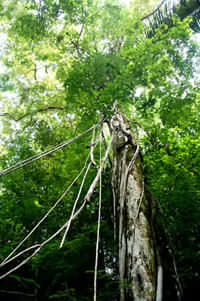
 |
 Biodynamic Gardening in the Tropics - Part 2 - Reforestation Advice
Biodynamic Gardening in the Tropics - Part 2 - Reforestation Advice
Mary Lynn Perry Rainsong has recently begun its Reproduction for Reintroduction of Endangered Species Project. We'll carry out breeding programs with various animal & bird species native to the area. Their young will be released back into natural habitat at the appropriate age, in family groups, for the continuing propagation of the species in the wild. The success of our attempt to restore species that have already disappeared in the area will depend on two important factors: 1. Suitable habitat available 2. Safety from human predators. Reforestation, protecting and enhancing existing wildlife corridors and habitat, and Conservation Education are the solutions to the problems involved with Reintroduction. Rainsong has an active Conservation Education Program working with the local schools to teach awareness & respect for animals' rights. The school children are very excited and responsive. We are confident that the next generation will not be involved in poaching, nest-robbing, or other predatory activities. Since the government of Costa Rica has recently increased the fines for poaching from c20,000 up to c500,000, the present generation is now less eager to poach. We need to continue cultivating community awareness to protect the existing populations of animals & birds, and subsequent releases thru Reintroduction. If you are interested in helping with Conservation Education in the area, please send us an email. Reforestation is something that everyone can help with. Even if you're renting, planting a few papaya trees & ylang ylang trees in your yard will attract a marvelous variety of birds, including toucans, momotos, trogons,etc. Papaya trees grow rapidly, and fruit within 6 months if planted with biodynamic techniques. Save your papaya seed, dry them a few days (in shade), then plant them. Papaya is a short-lived tree, normally 3 to 6 years. It doesn't take up much space in the garden, so plant as many as possible. Establish a birdfeeder in your yard. Bananas are cheap and attract many bird species. Plant flowers for the hummingbirds and butterflies. For suggestions of the best flowers to use, send us an email stating your purpose. Landowners can quickly & easily turn former pastures into habitat paradises for animals & birds. We also hope that more landowners will join our Penjamo Community Wildlife Refuge. This concept is unique & simple. Each landowner takes responsibility for protecting the wildlife on their property. The Colegio de Biologos de Costa Rica (governing body for Tico biologists) tells us the concept of a community wildlife refuge is so rare, there's only one other on the planet, in Africa. We find it ironic & disappointing that such a simple approach to Conservation is so unusual! Please help us promote awareness in your community. The following size and spacing info should help you with your Reforestation project. If you'd also like Rainsong to help, send us an email. Rainsong offers free consultations, on-site inspections for identification of existing trees ($20), suggestions for trees and plants to incorporate, help with spacing, landscape planning and mapping, advice about biodynamic gardening techniques (so your trees will develop quickly and fruit early), and organic maintenance of your gardens. We have an extensive collection of rare and endangered tropical hardwoods, and native fruit trees in our Reforestation Nursery. To promote reforestation we sell our trees for only $1 each. For tree lists visit our website: www.rainsongsanctuary.com Our nursery is open to the public every Saturday & Sunday, all day. NOTE: Although Ylang Ylang & several other trees we promote are not native species, the benefits they provide (fast-growing, fruit year-round) make them worthy to be incorporated into reforestation projects. Our biologists agree with this policy. Forest Flame (Llama Bosque) can become invasive if the seedlings are not controlled by clearing them out periodically. Because it grows so rapidly, we use it to close in gaps in wildlife corridors. TO ENHANCE AN EXISTING WILDLIFE CORRIDOR : (forest or tree line existing along fence lines or creeks ) Plant close to existing trees - 3 to 4 meters. Check that there's open sky above. Don't plant trees under the canopy unless it's very high. (Exceptions: shade-loving small trees--- cacao, café, pacaya palms, peacock palms, also guayaba (guava) trees thrive in some shade.). Trees with wide crown should be spaced 7 meters (mountain almond, manzana agua, cenizaro, mango, ardillo, etc.) Spacing is measured from tree trunk to tree trunk. Ylang Ylang is a tall narrow-crowned tree that grows very rapidly. Plant it between slower -growing trees, 4 meter spacing. Madero Negro also is a good choice. It grows rapidly, and many wildlife species eat the flowers. It also fixes nitrogen in the soil. TO CREATE A WILDLIFE CORRIDOR: Plant along your fence lines, as near to neighboring corridors as possible. Spacing - 4 to 7 meters, depending on the tree species. Use zig-zag lines to squeeze the trees in closer together. Plant smaller, fast-growing trees between the slower-growing hardwoods. For example: Ylang Ylang, Madero Negro, Malinchi, Papaya, Guanabana, Carambola (starfruit), Forest Flame, Orgullo Indio, etc. TROPICAL HARDWOODS. Despite what many people believe, many hardwoods grow rapidly. Some grow more rapidly than even teak. Please explore other options before you plant teak. Teak is SO TOXIC, it is a conservationists' nightmare and renders your soil and property unusable for other types of cultivations. PLEASE DO NOT PLANT TEAK !!!! |

| Copyright 2005 by Rainsong Wildlife Sanctuary All Rights Reserved |